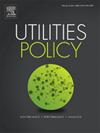Power generation and transmission capacity expansion planning considering renewable energy and emissions policies in South Korea
IF 4.4
3区 经济学
Q3 ENERGY & FUELS
引用次数: 0
Abstract
The growth in energy consumption necessitates long-term power generation and transmission expansion planning. Given the government's goal of increasing the role of renewable energy and decreasing carbon emissions through renewable portfolio standards and carbon emissions trading policies, expansion planning considering the operational structure of these two policies should be applied. To that end, an optimization model was built and applied in South Korea. By solving the nominated optimization problem, the optimal power generation and transmission capacity plan, optimal transmission layout, RE ratio, and carbon emissions rate are determined as the model results. The integrated efficiency of renewable portfolio standards and the emissions trading scheme is revealed through extensive experiments.
考虑到韩国的可再生能源和排放政策的发电和输电容量扩大规划
能源消费的增长需要长期的发电和输电扩张规划。考虑到政府通过可再生能源投资组合标准和碳排放交易政策来提高可再生能源的作用和减少碳排放的目标,应该考虑这两项政策的运行结构进行扩张规划。为此,建立了一个优化模型,并在韩国进行了应用。通过求解指定的优化问题,确定最优的发电和输电容量方案、最优输电布局、RE比和碳排放率作为模型结果。通过大量的实验,揭示了可再生能源组合标准与排放交易机制的综合效率。
本文章由计算机程序翻译,如有差异,请以英文原文为准。
求助全文
约1分钟内获得全文
求助全文
来源期刊

Utilities Policy
ENERGY & FUELS-ENVIRONMENTAL SCIENCES
CiteScore
6.80
自引率
10.00%
发文量
94
审稿时长
66 days
期刊介绍:
Utilities Policy is deliberately international, interdisciplinary, and intersectoral. Articles address utility trends and issues in both developed and developing economies. Authors and reviewers come from various disciplines, including economics, political science, sociology, law, finance, accounting, management, and engineering. Areas of focus include the utility and network industries providing essential electricity, natural gas, water and wastewater, solid waste, communications, broadband, postal, and public transportation services.
Utilities Policy invites submissions that apply various quantitative and qualitative methods. Contributions are welcome from both established and emerging scholars as well as accomplished practitioners. Interdisciplinary, comparative, and applied works are encouraged. Submissions to the journal should have a clear focus on governance, performance, and/or analysis of public utilities with an aim toward informing the policymaking process and providing recommendations as appropriate. Relevant topics and issues include but are not limited to industry structures and ownership, market design and dynamics, economic development, resource planning, system modeling, accounting and finance, infrastructure investment, supply and demand efficiency, strategic management and productivity, network operations and integration, supply chains, adaptation and flexibility, service-quality standards, benchmarking and metrics, benefit-cost analysis, behavior and incentives, pricing and demand response, economic and environmental regulation, regulatory performance and impact, restructuring and deregulation, and policy institutions.
 求助内容:
求助内容: 应助结果提醒方式:
应助结果提醒方式:


